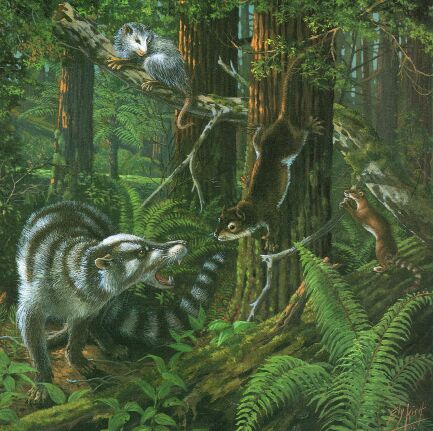
| Paleocene Epoch | ||
| Cenozoic: Paleogene Period |
Paleocene |
| Late Cretaceous | Cretaceous | Paleogene | ||
| Eocene | Neogene | Danian | Time |
|
Mesozoic |
|

The Paleocene ("ancient recent life") epoch marks the beginning of the Paleogene Period and the Cenozoic era. The sea-level fell to expose dry land in much of inland North America, Africa, and Australia. South America however was cut adrift with its own unique evolving "ark" of birds, mammals, and reptiles.
At sea, gastropods and bivalves were very similar to modern forms. Soft-bodied squid replaced the hard-shelled ammonites as the leading molluscs. New kinds of sea urchins and foraminifers replaced Mesozoic types that had been killed off in the great terminal Cretaceous extinction. Among fishes, sharks seem to have been particularly plentiful.
On land, many new types of mammals appear in a dramatic evolutionary radiation, filling the ecological roles vacated by the dinosaurs. But compared to the majestic Cretaceous megafauna, these animals were puny. No Paleocene mammal exceeded the size of a small modern bear, and most were a lot smaller. They were all short-legged and plantigrade (walking on the soles of their feet), and they had five toes on each foot, a primitive feature. Most or all have fourty-four low crowned teeth, another primitive feature. Almost all of them had slim heads with narrow muzzles and small brain cavities. In terms of brain to body weight ratios they were well below late Cenozoic mammals. A number of typical Paleocene mammals are shown in the following sketch by Dr Bob Bakker.

The predominant mammals of the period were members of groups that are now extinct. These included the flesh-eating Mesonychia, such as Dissacus (=Hyaenodictis) known from the Middle Paleocene Middle Eocene of Europe, East Asia, and North America [family Mesonychidae], which were actually (believe it or not) ancestral to the whales; and Creodonta; and the mostly herbivorous Condylartha (e.g. Periptychus (top center) - early Paleocene of North America, family Periptychidae)), which first appeared in the guise of the latest Cretaceous Protungulatum, and were light-bodied animals; and the pantodonts such as Pantolambda (middle Paleocene of North America - family Pantolambdidae) and Dinocerata, which were as yet still small to medium-sized, but heavy-bodied animals, all with small brains. Other Paleocene groups included Cretaceous survivors such as the multituberculates, the marsupials, and several groups of the insectivores and insectivore-like mammals, and the Plesiadapiformes, a group of squirrel-like animals more or less transitional between insectivores and primates. Other Paleocene mammals included two unrelated groups of large clumsy herbivores, the Tillodonts and the Tainodonts, the latter group including Psittacotherium bottom left, middle Paleocene of North America, family Stylinodontidae). Also living at this time, but still insignificant, were the first representatives of the rodents and the Miacidae, the ancestors of modern Carnivora.
By the start of the Tertiary the present continental land masses were largely separate, and so independent evolutionary radiations of mammals took place in these relatively isolated areas). This allowed the well-known marsupial fauna of Australia to develop. Until the end of the Tertiary, South America was similarly isolated from the north and likewise developed a unique fauna. Until the middle Tertiary the faunas of Africa were also clearly distinct from those of Eurasia.
Many Paleocene mammals seem to have developed in northern Asia and migrated from there to the rest of Asia, to Europe and to North America, these made up the typical Laurasian fauna of the time. The Paleocene inhabitants of the scattered continents of Gondwana are only poorly known, if at all. As mentioned, South America-Antartica-Australia, New Zealand, India, and Africa, were all isolated from each other and from other parts of the world, and served as island arks and centers of evolution where unique types of placental mammals, marsupials, monotremes, birds, reptiles, and in the case of New Zealand the last surviving Sphenodontia, were able to develop in safety.
The Paleocene carnivorous mammals of Laurasia had to share their world with giant flightless birds of prey like Diatryma and it's cousins (order Diatrymiformes), which appear suddenly during the late Paleocene and continue through to the Middle Eocene. Standing 2 meters or more in height and weighing in at around 200 kg, these large-beaked birds were the biggest and fiercest animals on land for some five or ten million years. In South America similar giant predatory birds, the Phorusrhacids, are known from the Eocene but most probably likewise evolved during the Paleocene. These great birds were the last successors of the mighty theropod dinosaurs of the Mesozoic.

Epoch |
Standard Age |
representative animal |
|---|---|---|
Paleocene Epoch |
Thanetian |
|
Danian |
|
University of California Museum of Paleontology -- The Paleocene Epoch - best overall intro
Paleocene mammals of the world - Martin Jehle's superb coverage of Paleocene Mammals - Best on the Web
Paleocene epoch- mirror - short intro
The Paleocene - short intro
The Fossil Record of North American Mammals: Evidence for a Paleocene Evolutionary Radiation - John Alroy